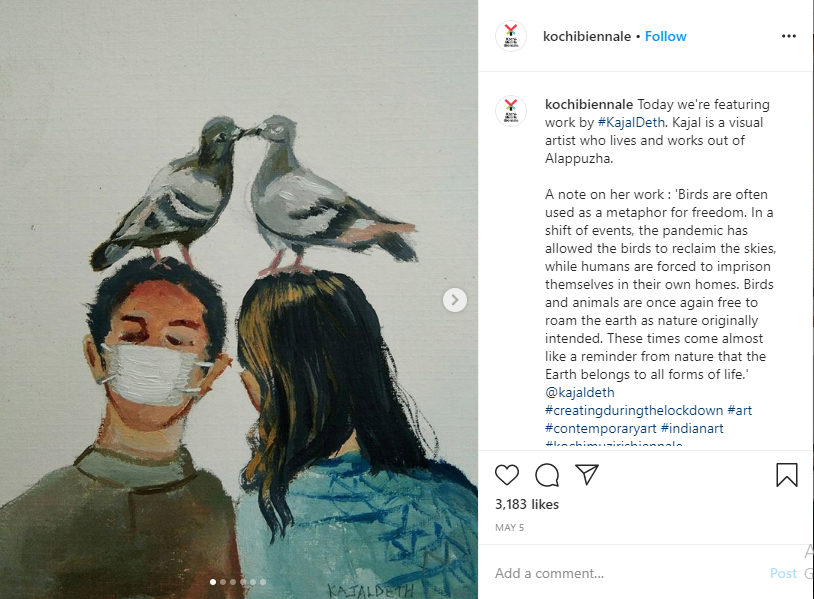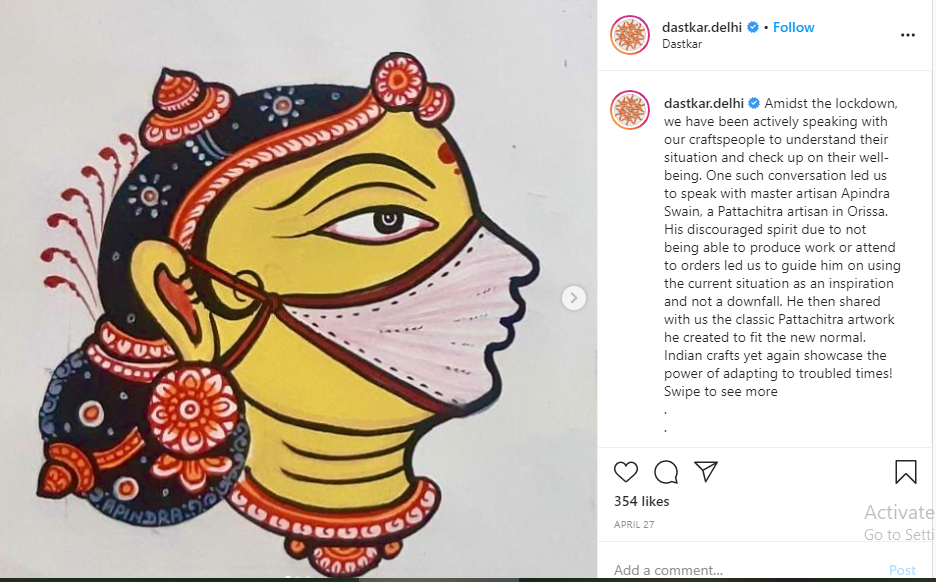
“To preserve the past is to save the future,” said author Nanette L Avery. With life coming to a standstill amid the global lockdown, the coronavirus pandemic is being viewed in a billion ways through a billion eyes.
All over the world people are recording their lockdown experience and all these experiences are increasingly becoming works of art. Keeping this historical period in mind, museums and art galleries are calling people to share their personal experiences of the lockdown period to preserve them as photographic and documentary evidence for the generations to come.
People are wielding their pens, pencils and brushes to portray their anguish towards the future, solidarity towards the lesser privileged, sadness towards those who passed away and joy towards those who come back home. Everything from working from home during the lockdown – whether home now feels like a palace or a prison too is an experience being recorded during the pandemic.
The world has become a large repository of emotions – from fear to gratitude and from love to hope while it is hurling through the pandemic.
The heritage sector is in the process of making what we can call the “pandemic archives” to be viewed as a time that brought about not only significant social, cultural and cultural changes, but also a trying time that the world collectively conquered with resilience and courage.
Calling for pandemic art
Writing for The Telegraph India Sudipta Bhattacharjee said, “Covid-19 and the subsequent global lockdown has already spawned enough material by way of photographs, art, writing and cartoons to merit another exhibition in the coming days. The wealth of documentation has resulted in online journals, websites and crowd-sourced projects to digitally collect people’s reactions to this unprecedented scenario that has befallen the world. A friend in El Paso has created a space to archive thoughts and ideas on how we are dealing with this unique period. The University of Wisconsin-Madison Archives has invited recollections of how students are experiencing the ongoing situation through digital journal and diary entries, emails, photographs, videos, voice memos and audio recordings, digital art and other memoirs of how the campus community has been affected.”
The St. Fagans National Museum of History in Cardiff, along with other UK institutions, is calling on the public to document their experiences – lows and anxieties of this unsettling time. People have also been asked to photograph meaningful objects from their homes and communities for an online gallery. Eventually acquired for the museum’s collection will be artefacts like hand-painted signs, The Guardian said.
We want to hear about your experiences and feelings of living in Wales during #Covid19 crisis.
Take part in our questionnaire to create a national memory and record of the pandemic in Wales.https://t.co/4nL7bu9mLv#CollectingCovid #Museumfromhome pic.twitter.com/T84wOHZD62
— Sain Ffagan|StFagans (@StFagans_Museum) May 15, 2020
In London, the V&A, has been building up an online exhibition called Pandemic Objects, with curators exploring the significance of some potent physical symbols of the lockdown life – glocves and masks.
From closures to messages of hope, homemade signs have become a vital way for us to communicate during lockdown. We want to collect these signs to preserve a portrait of life under lockdown. https://t.co/yI8gKiGK60
Share your signs to #homemadesigns or homemadesigns@vam.ac.uk pic.twitter.com/iDqcy6og9V
— V&A (@V_and_A) May 12, 2020
“It’s such an extraordinary experience,” Beatrice Behlen, senior curator at the Museum of London, told AFP. “When we knew there was going to be a lockdown, we started straight away talking about what we needed to collect something for the future.” The Deccan Herald reported the curator as saying that they are looking out not for objects, but for the story behind it. It could be your favourite slippers or a skill you’ve picked up, it must mean something to you.
In India, as a part of the Sunaparanta Goa Centre for the Arts’ series “Surviving SQ” (self- quarantine), artist Pallavi Paul asked people to send around 10-second audio clips of the silence in their confined environments. “It [represents] the churning of the world. It’s devoid of all suggestions of the complex vortex that we find ourselves in,” said Paul. “And we know this is not a silence of leisure. It’s a pregnant silence, fertile, with many possibilities. Things are changing in this silence.”
#Videoartist Pallavi Paul archives the silence of the pandemic through her ongoing project ‘Share Your Quiet’, inviting people to share 10sec sounds of everyday ‘quiet’ as an alternative way to cope with the #lockdown.
Read/Watch full video: https://t.co/zFmwiP5Mst#STIRworld pic.twitter.com/ct94BTSxFA
— STIRworld (@stir_world) April 30, 2020
Art for social messaging
In an online stay-safe campaign launched by artist S Nagaraj in Coimbatore, people were asked to make a self-portrait wearing a mask and send it to him. He told The Hindu that he got the idea when he read about the Chennai Police making giant paintings on the roads to explain the importance of social distancing.
Dastkar, India’s prominent society for crafts and craftspeople has worked with folk artists to produce artwork to convey the importance of social distancing, wearing masks and washing hands with soap for social messaging, reported BBC. Artists have used the Madhubani style, Phad painting and Pattachitra among others to put emphasize on the message of safety during the pandemic.

A large number of museums and galleries around the world are investing in the same idea – of collecting “lockdown memories”.
Museums, galleries and zoos come home
For the ones feeling left out of the joy of visiting zoos, museums and art galleries, owners and curators have made sure that they enter people’s homes through online live streaming.
In India, the joy of witnessing the unfiltered activity of animals sans the interference of humans has become an activity to look forward to. Museums are hosting virtual walkthroughs and the idea is proving profitable and fulfilling.
The Alipore Zoo in Kolkata, the oldest in India, has launched a mobile application to help people take a virtual tour – where citizens can see a panoramic view of the zoo, check photos of the animals and know more about an animal they’re particularly interested in.
For the Arignar Anna Zoological Park in Chennai, the first to start live streaming of their enclosures two years ago, the online viewership is going solid with its webpage getting almost 60,000 – 80,000 views everyday during the lockdown.
@VandalurZoo has been actively involved in virtual activities to engage children during the lockdown through Live Virtual Zoo, Drawing competitions and Poster making. Soon the zoo is coming up with live sessions. Keep watching your timeline. Stay connected Stay Positive? https://t.co/QV9tjyTkzx
— Sudha Ramen IFS ?? (@SudhaRamenIFS) April 21, 2020
The National Council of Science Museums (NCSM) has organized panel discussions on Covid-19, DIY activities and observation programs like the Super Pink Moon during the pandemic.
The National Gallery of Modern Art (NGMA) Delhi, paid a virtual tribute to Raja Ravi Varma in his 172nd anniversary year.
Virtual Tour | Display of Permanent Collection of NGMAhttps://t.co/ohM7CIXFel…
Video credit : Passionate participants of the ‘Art of Documentary’ workshop. pic.twitter.com/6lTyr86y4x— NGMA Delhi (@ngma_delhi) May 15, 2020
The Anglo-Sikh museum in UK used 3D technology to bring to life objects related to Ango-Sikh history – weaponry, coins and Maharani Jindan’s jewellery.
You might have seen the #kohinoor @TowerOfLondon but not like this. See our #3d version @Taran3D @BBCNews @itvnews @britishlibrary @britishmuseum @Royal_Armouries @guardiantech @bbcasiannetwork pic.twitter.com/R6e77fbCEk
— SMI (@sikhmuseumi) April 20, 2020
The Kochi-Muziris Biennale, an international exhibition of contemporary art, too has gone online big time and is sharing artists’ reflection on the pandemic and life in quarantine. Like artist Kajal Deth uses birds as a metaphor for freedom. For her, ‘these times come almost like a reminder from nature that the Earth belongs to all forms of life’.

Opening cautiously amid the crisis
With Covid-19 cases slowly on the decline and new rules being put into place, museums all over the world are slowly re-opening albeit with cautions. Museums in Berlin were allowed to reopen on May 4, but many remain closed to figure out logistics and safety procedures, The Art Newspaper reported.
Italian Prime Minister, Giuseppe Conte, too outlined lockdown easing measures which included reopening museums, cultural venues and libraries on 18 May. However, Conte warned: “If we do not respect the precautions the curve will go up, the deaths will increase, and we will have irreversible damage to our economy. If you love Italy, keep your distance.”
Art aficionados abroad who took the risk of going for tours after some museums opened recounted that though it was a relief to see art in person, the experience of viewing wasn’t as relaxing and freeing due to the masks and requirement to observe social distancing, reported NY Times.
Private galleries and museums in India are awaiting orders by the government on when they can re-open. For now, as coronavirus cases in India are on the rise, online tours and online sales are the only way to go. Museumologists say that now virtual museums will suffice, but post the pandemic they will have to find a way to remain relevant and adapt to social distancing rules in an innovative manner.
The process of gathering memories is to make what we can effectively call a coronavirus catacomb – a place that will hold the pandemic memories till the end of time. It is this time that people will speak about, when the world stayed at home to view the world outside.
When viewed days, months, years or even decades later, it is this art that will tell the story of man’s greed, his mistakes, his hope, his courage, his sacrifices and his undying spirit that helped tide through the epidemic.
(Sources – The Tribune, The Hindu, Firstpost, The Print, Hindustan Times)